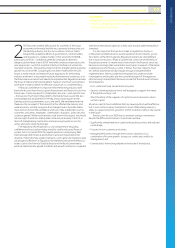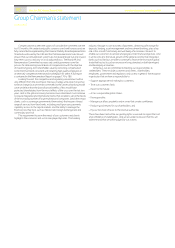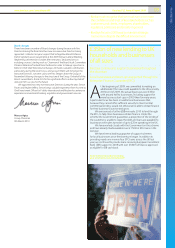Barclays 2009 Annual Report Download - page 19
Download and view the complete annual report
Please find page 19 of the 2009 Barclays annual report below. You can navigate through the pages in the report by either clicking on the pages listed below, or by using the keyword search tool below to find specific information within the annual report.
www.barclays.com/annualreport09 Barclays PLC Annual Report 2009 17
Barclays during this cycle. That is one of the principal benefits of the universal
banking model; the others include: capital and funding efficiencies; and
business and risk diversification. Forcing banks to adopt ‘narrow’ business
models, as some have suggested as part of the ongoing reform dialogue, will
not make the system safer. There has been no correlation so far in this crisis
between ‘failure’ and the popular dichotomies drawn of bank business models:
big or small; narrow or broad; domestic or international.
Maintaining Strategic Momentum: Despite the regulatory uncertainty
that will continue to confront the industry this year, our strategic path remains
clear – to increase the growth potential of Barclays by continuing to diversify
our business by customer, product and geography. That strategy lay behind
the broadening of our executive Committee
b
and changes to senior
management responsibilities that I announced in November 2009.
The executive Directors of the Group, Bob Diamond, Group President,
Chris Lucas, Group Finance Director, and myself, have been joined on
the Executive Committee by the leaders of a number of Barclays business
units and control and governance functions. We have also regrouped our
activities to form:
– Global Retail Banking (GRB), comprising UK Retail Banking, Barclaycard
and the former Western Europe and Emerging Markets businesses, led by
Antony Jenkins.
– Corporate and Investment Banking (CIB), comprising Barclays Capital
and Barclays Commercial Bank (now called Barclays Corporate);
Jerry del Missier and Rich Ricci are Co-Chief Executives of Corporate and
Investment Banking.
GRB focuses on mass consumers, mass affluent consumers and small
business customers. We have significantly changed the footprint here
over the past three years, and we intend to push that forward, increasing,
through time, the ratio of non-UK to UK business whilst strengthening our
UK franchises. We will place particular emphasis on creating appropriate
scale in the markets in which we have a presence. As we do that, our
objectives will be four-fold: profit growth; an improved loan-to-deposit ratio;
further international diversification through deepening existing presences;
and the generation of net equity.
Barclays Corporate, as part of CIB, focuses on the high end of what we
used to call Barclays Commercial, particularly financial institutions, public
sector entities and corporate clients. We brought this business alongside
Barclays Capital within CIB because we see significant synergy in sharing
relationship management and sector expertise across the two. Realisation
of that synergy is enabled by the increasing fungibility of client requirements
between traditional corporate banking and investment banking product
needs within our client base. This is a global opportunity with significant
income growth potential for CIB in the years ahead. Our early work has only
reinforced that strongly held belief.
In the area of wealth management, the competitive landscape in the
global industry has gone through a sea change over the course of the last
three years. That creates opportunity, and we intend to seize that by
investing to change the scale of this business over the next five years.
Remuneration
Recognising the political and regulatory focus on remuneration practices,
and the interest of both our shareholders and our staff in the topic, it is
important for me to say that we see compensation as a means of supporting
the implementation of strategy in a way that best serves the interests of our
shareholders. So our objective in this area is to ensure that we use
remuneration well, making it the servant of the interests of our owners.
We aim to achieve an appropriate balance between paying dividends to
shareholders, investing in the business, strengthening our capital ratios and
paying staff appropriate compensation. I don’t pretend that achieving that
balance is always easy, or that the judgements involved are straightforward.
The market for the best people is both global and intensely competitive.
Banking is a service industry and, if we are to remain successful, we must
attract and retain the best people. We have to pay for performance but,
I emphasise, we seek to pay no more than the amount consistent with
competitiveness.
Our compensation framework is determined by the Board HR and
Remuneration Committee, a sub-committee of the Group Board
which is chaired by our Deputy Chairman, Sir Richard Broadbent. My
recommendations to the Remuneration Committee and its decisions are
only made after appropriate input from the Board Group Risk Committee
and the Group Chief Risk Officer to ensure that the level of risk within the
business and the quality of underlying profits generated are taken properly
into account. The Remuneration Committee has also considered the impact
on profits of our usage of Government and Central Bank schemes, higher
liquidity requirements and the shape of the yield curve.
Our discretionary pay awards for 2009 are fully compliant with the
FSA Remuneration Code and the Financial Stability Board Implementation
Standards, endorsed by the G20. This has resulted in an increase in the
deferred awards by approximately 70% and greater use of equity in deferral
structures, particularly to senior staff. 100% of the discretionary pay awards
for 2009 to our Executive Committee will be deferred.
Corporate and Investment Banking and Wealth Management
In November 2009 we announced changes
to the management structure and leadership
team of the Barclays Group. The formation of
Corporate and Investment Banking and Wealth
Management was designed to accelerate
the execution of our strategy, continue to adjust
dynamically to the changing environment, and
respond rapidly to client and customer needs.
Now is the time for execution, for capitalising
on the progress we have made and for seizing
the opportunity before us.
By moving Commercial Banking, now
Barclays Corporate, into the new Corporate and
Investment Banking and Wealth Management
grouping, we signalled our desire to extend the
already attractive synergies and working
practices among our three global businesses,
Barclays Corporate, Barclays Capital and Barclays
Wealth. Barclays Corporate is a great business,
with superb relationships, a client-focused
culture, and outstanding prospects around
the globe.
Barclays is now one of a handful of leading
global universal banks able to offer the full array
of products and services to clients, and we are
gathering momentum as we increase market
share in all our franchises. This new structure
allows us to serve our clients even better.
We have a unique opportunity, and we are
determined to take advantage. We have the right
model, the right culture and the right people to
succeed as long as we continue to manage our
risks and our costs, deliver flawless execution of
our plans, and maintain our momentum. Most
important of all, however, we must as always,
stay close to our clients who need us more
than ever.
Robert E Diamond Jr
Chief Executive,
Corporate and Investment Banking
and Wealth Management
























